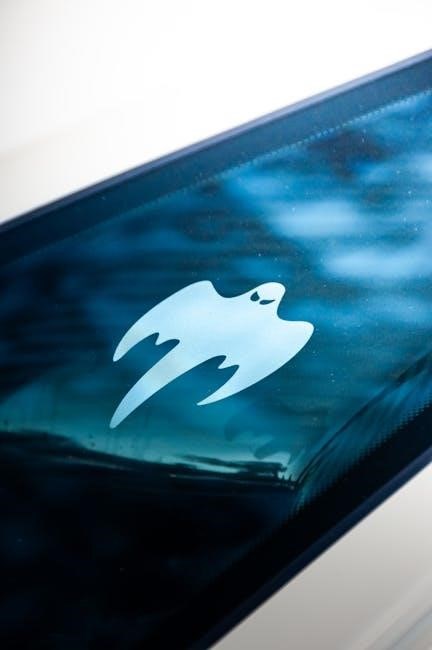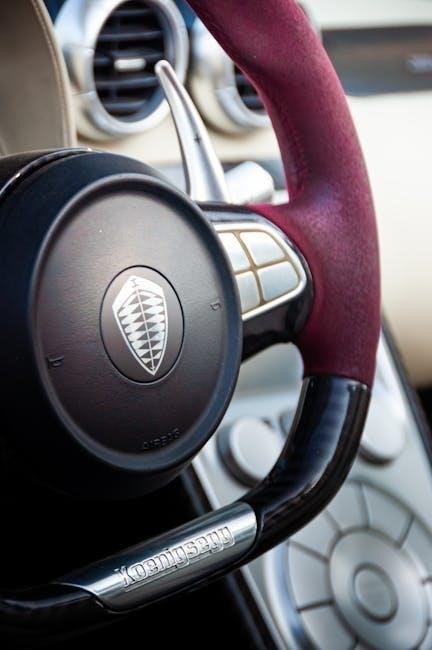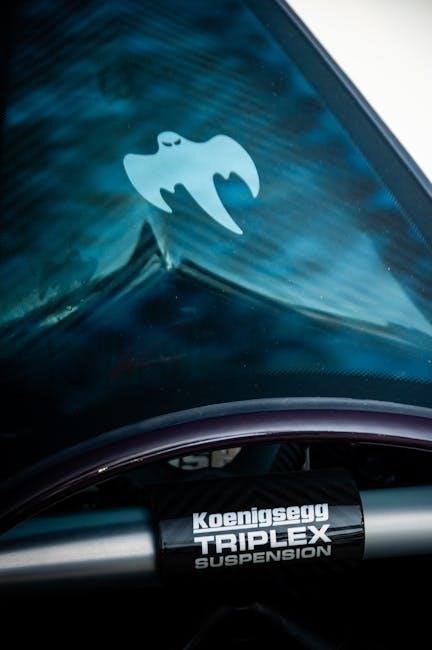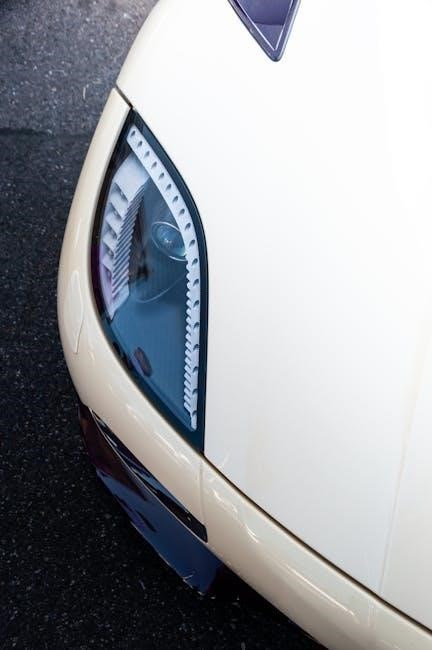The FireAngel Carbon Monoxide Detector is a vital safety device designed to detect dangerous CO levels in your home, ensuring early warning and user-friendly operation.
1.1 What is a Carbon Monoxide Detector?
A carbon monoxide (CO) detector is a life-saving device designed to detect dangerous levels of carbon monoxide gas in the air. It works by sensing CO concentrations and triggering an alarm if they exceed safe thresholds. The FireAngel CO detector, for example, uses an advanced electrochemical sensor to monitor CO levels continuously. These devices are essential for early warning, as CO is odorless, colorless, and highly toxic. They are particularly crucial in homes with fuel-burning appliances, ensuring the safety of occupants by providing timely alerts. Modern detectors like FireAngel’s also feature LED indicators, test buttons, and loud alarms to ensure reliability and user awareness.
1.2 Why is a Carbon Monoxide Detector Important?
A carbon monoxide detector is crucial for protecting lives, as carbon monoxide is a silent, odorless, and deadly gas. It can accumulate in homes due to faulty fuel-burning appliances, such as boilers, heaters, or generators, leading to severe health risks. CO poisoning can cause headaches, dizziness, nausea, and even death in high concentrations. A detector like the FireAngel CO alarm provides early warning, enabling residents to evacuate and seek help before symptoms worsen. Its continuous monitoring ensures safety, especially during sleep, when victims may not awaken. Installing a CO detector significantly reduces the risk of poisoning, offering peace of mind and protecting against this invisible threat.

Technical Specifications
The FireAngel CO detector features an advanced electrochemical sensor, certified to EN 50291-2010 and EN 50292-2010 standards, ensuring reliable detection with an 85dB alarm and a 10-year warranty.
2.1 Sensor Type and Accuracy
The FireAngel Carbon Monoxide Detector utilizes an advanced electrochemical sensor, renowned for its precision in detecting low CO levels. This sensor technology ensures early warnings, safeguarding against toxic exposures. The device is engineered to minimize false alarms caused by common household contaminants, enhancing reliability. Its accuracy is certified to European standards EN 50291-2010 and EN 50292-2010, guaranteeing dependable performance. The sensor continuously monitors CO levels, providing real-time data to protect occupants. This technology is vital for maintaining user trust and ensuring the detector operates effectively in various home environments.
2.2 Certification and Compliance
The FireAngel Carbon Monoxide Detector adheres to stringent European safety standards, specifically EN 50291-2010 and EN 50292-2010. These certifications ensure the device meets rigorous performance and reliability criteria. Compliance with these standards guarantees that the detector can accurately identify dangerous CO levels and provide timely alerts. Additionally, the product is backed by a 10-year warranty, reflecting its durability and quality. By meeting these certifications, FireAngel ensures the detector’s effectiveness in safeguarding homes across Europe. This compliance also underscores the manufacturer’s commitment to delivering a trusted and dependable safety solution for users.
2.3 Alarm Levels and Indicators
The FireAngel Carbon Monoxide Detector features distinct alarm levels and indicators to ensure clear communication of potential threats. The device emits a loud 85dB alarm at 1 meter to alert occupants of dangerous CO levels. Visual indicators include LED lights that signal power status and alarm activation, providing immediate feedback. The detector monitors CO levels in parts per million (ppm), with thresholds set to trigger alerts at 35ppm for continuous exposure and higher levels for acute threats. These indicators ensure timely warnings, allowing occupants to take necessary actions to ensure their safety; The alarm system is designed to be both audible and visual, catering to different needs and ensuring comprehensive alerting capabilities.
2.4 Product Features and Benefits
The FireAngel Carbon Monoxide Detector offers advanced features for enhanced safety and convenience. Its electrochemical sensor provides accurate and reliable detection of CO levels, ensuring early warnings. The device is compact and lightweight, making it easy to install and transport. Key features include a test/reset button for regular maintenance, LED indicators for alarm and power status, and compliance with European safety standards (EN 50291-1:2010 and EN 50291-2:2010). The detector also boasts a 10-year warranty, providing long-term reliability. These features collectively offer a robust solution for protecting homes from CO threats, ensuring both safety and peace of mind for users. The combination of advanced technology and user-friendly design makes it an essential addition to any home safety system.

Understanding the User Manual
Understanding the user manual is crucial for proper installation, testing, and maintenance of your FireAngel CO detector, ensuring safety and reliability with clear guidelines and symbols explained.
3.1 Symbols and Indicators Explained
The FireAngel Carbon Monoxide Detector uses specific symbols and indicators to communicate its status. The LED lights are a key feature: a steady green light indicates normal operation, while a flashing red light signals an alarm. A yellow or amber light may indicate a fault or low battery. The test/reset button is used to check the detector’s functionality and reset it after an alarm. Additional symbols in the user manual, such as the alarm icon or warning signs, provide visual guidance for installation, testing, and troubleshooting. Understanding these symbols ensures proper use and maintenance of the detector, enhancing safety and reliability. Always consult the manual for unfamiliar symbols to ensure correct interpretation and response.
3.2 Key Components of the Detector
The FireAngel Carbon Monoxide Detector consists of essential components designed for optimal performance. The advanced electrochemical sensor accurately detects CO levels, ensuring early warning. The unit includes an 85dB alarm to alert occupants during emergencies. LED indicators provide visual status updates, such as power confirmation and fault detection. A test/reset button allows users to check functionality and silence false alarms. The detector’s compact design includes mounting hardware for wall installation or placement on surfaces. Battery-powered models offer portability, while sealed units provide a 10-year lifespan. These components work together to deliver reliable protection against carbon monoxide threats, ensuring user safety through continuous monitoring and clear alerts. Proper understanding of each part is crucial for effective use and maintenance.

Installation Instructions
Ensure the detector is installed at head height, away from obstructions, and near sleeping areas for optimal detection and alarm audibility in case of carbon monoxide presence.
4.1 Where to Install the Detector
The FireAngel Carbon Monoxide Detector should be installed in every room containing a fuel-burning appliance, such as boilers or heaters, and in all sleeping areas. Ideally, place the detector at head height and near where people spend most of their time while awake. For rooms with sloped ceilings, position the detector on the higher side. Avoid installing near doors, windows, or obstructions, as this may reduce its effectiveness. If multiple fuel-burning appliances are present, prioritize rooms where occupants spend more time and ensure detectors are within hearing range of sleeping areas. This ensures early warning and optimal safety. Proper placement enhances detection accuracy and response time, protecting you and your family effectively.
4.2 How to Install the Detector
To install the FireAngel Carbon Monoxide Detector, begin by selecting a suitable location based on the manufacturer’s guidelines. For wall mounting, use the provided screws and wall plugs, ensuring the detector is at least 150mm below the ceiling. If placing on a shelf, choose a stable surface away from direct sunlight and moisture. Activate the detector by removing the pull tab to power on the battery. Test the alarm by pressing the test button until the LED flashes and the alarm sounds. Ensure all household members can hear the alarm from any room, especially sleeping areas; Proper installation is crucial for reliable performance and safety. Follow the user manual for detailed steps to ensure your detector functions correctly and provides early warnings of dangerous CO levels. Regular testing and maintenance will ensure ongoing protection for your home and family.
4.3 Wall Mounting vs. Placement Guidelines
For wall mounting, install the FireAngel detector 1-3 meters from potential CO sources, at least 150mm below the ceiling, and away from windows or doors to avoid drafts. Ensure it is on the same side of any room partition as the fuel-burning appliance. For placement on a shelf, choose a stable, flat surface away from direct sunlight or moisture. The detector should be at head height or near sleeping areas for optimal alerting. Avoid areas with high humidity or extreme temperatures. Proper placement ensures accurate detection and reliable alarm performance. Always follow the manufacturer’s guidelines to maximize safety and effectiveness. Correct installation is key to protecting your home and family from carbon monoxide threats.

Testing and Maintenance
Regularly test the FireAngel detector using the test-reset button to ensure proper functionality. Maintain by cleaning dust and ensuring battery replacement as needed for optimal performance.
5.1 How to Test the Detector
To ensure your FireAngel Carbon Monoxide Detector is functioning correctly, press and hold the test-reset button until the alarm sounds. This verifies the sensor and alarm are working. The detector will emit a loud, continuous beep at 85 decibels, confirming its operational status. Regular testing is essential to guarantee your safety and should be performed monthly. Additionally, the device performs self-checks automatically, but manual testing provides peace of mind. If the alarm does not sound during testing, check for any obstructions or damage and ensure proper installation. A functioning detector is critical for early warning in case of carbon monoxide presence.
5.2 Regular Maintenance Tips
Regular maintenance ensures optimal performance of your FireAngel Carbon Monoxide Detector. Dust and debris can accumulate, so gently vacuum the grille monthly to prevent interference. Avoid using chemicals or damp cloths, as they may damage the sensor. Check the LED indicators regularly; a flashing green light confirms proper function, while a red light signals an issue. Replace batteries annually or as indicated, and ensure the detector is securely mounted. Additionally, inspect for any physical damage or wear. By following these steps, you maintain reliability and extend the detector’s lifespan, ensuring continuous protection against carbon monoxide threats in your home.
5.3 Battery Replacement and Care
Replace the batteries in your FireAngel Carbon Monoxide Detector annually or when the low-battery warning sounds. Use high-quality, non-rechargeable batteries of the specified type (e.g., AA or 9V). Avoid mixing old and new batteries or using rechargeable ones, as this may reduce performance. When replacing, ensure the detector is turned off and batteries are inserted correctly. Dispose of old batteries safely, following local regulations. Store spare batteries in a cool, dry place away from metal objects to prevent accidental discharge. Proper battery care ensures uninterrupted protection and maintains the detector’s reliability in detecting harmful CO levels in your home.

Troubleshooting
Common issues include false alarms, sensor malfunctions, or connectivity problems. Reset the detector, check for blockages, and ensure proper installation. Consult the manual or contact support if issues persist.
6.1 Common Issues and Solutions
Common issues with the FireAngel CO detector include false alarms triggered by household fumes or dust. To resolve this, clean the sensor with a soft brush and ensure proper ventilation. If the alarm sounds without cause, press the test/reset button to silence it. For persistent problems, check for sensor blockages or outdated software. Ensure the detector is installed at least 1 meter away from fuel-burning appliances. If issues remain, contact FireAngel’s technical support team for assistance or replace the unit if necessary. Regular maintenance can prevent many of these issues.
6.2 Resetting the Detector
To reset the FireAngel CO detector, press and hold the test/reset button for 10 seconds until the alarm stops. This resets the detector to its standby mode. If the alarm persists, ensure no CO is present and ventilate the area. If the issue remains, check for sensor blockages or outdated software. For persistent problems, contact FireAngel’s technical support or replace the unit if necessary. Regular resets can help maintain functionality, but ensure the detector is properly calibrated after each reset. Always refer to the user manual for detailed reset instructions specific to your model.

Understanding Carbon Monoxide
Carbon monoxide is a dangerous, odorless, and invisible gas produced by incomplete combustion of fossil fuels, posing severe health risks by replacing oxygen in the blood.
7.1 What is Carbon Monoxide?
Carbon monoxide (CO) is a toxic, odorless, colorless gas formed by incomplete combustion of carbon-containing fuels. It is produced by vehicles, heaters, boilers, and appliances burning fossil fuels. CO is dangerous because it replaces oxygen in red blood cells, disrupting oxygen delivery to vital organs like the heart and brain. High concentrations can lead to unconsciousness or death within minutes. Known as the “silent killer,” CO is undetectable without a detector, making it crucial to use devices like the FireAngel CO alarm for early detection and prevention of poisoning.
7.2 Sources of Carbon Monoxide
Carbon monoxide is produced by incomplete combustion of carbon-containing materials. Common sources include faulty or improperly maintained fuel-burning appliances like boilers, heaters, and stoves. Blocked chimneys, clogged vents, and malfunctioning flues can also lead to CO buildup. Portable generators, idling vehicles in confined spaces, and smoking indoors contribute to CO exposure. Additionally, improperly installed or ventilated appliances, such as gas cookers and water heaters, can release CO. Understanding these sources is crucial for preventing exposure and ensuring safe living conditions, which the FireAngel detector helps monitor.
7.3 Health Effects of CO Poisoning
Carbon monoxide poisoning occurs when CO displaces oxygen in the blood, reducing oxygen delivery to vital organs. Mild exposure causes headaches, nausea, and fatigue, often mistaken for flu-like symptoms. Prolonged exposure leads to severe headaches, dizziness, confusion, and rapid heartbeat; High concentrations can cause unconsciousness, convulsions, and even death within minutes. CO poisoning can also lead to long-term health issues, including brain damage and heart problems. Early detection is critical, as symptoms can progress rapidly, especially in sleeping individuals; The FireAngel detector plays a crucial role in alerting occupants to dangerous CO levels, enabling timely evacuation and medical intervention.
7.4 Safe Levels of Carbon Monoxide
Safe carbon monoxide levels are crucial for preventing poisoning. According to guidelines, continuous exposure to 35ppm is the maximum safe level for healthy adults over an 8-hour period. Prolonged exposure to 200ppm can cause mild symptoms like headache and fatigue within 2-3 hours. At 400ppm, severe symptoms such as frontal headaches and life-threatening conditions develop within 3 hours. Concentrations of 800ppm lead to dizziness, nausea, and unconsciousness within 45 minutes, while levels above 1,600ppm can cause death in just 1-2 minutes. The FireAngel detector monitors these levels, ensuring early warning to protect against these dangerous thresholds and prevent CO-related harm.

Safety Guidelines
- Always install CO detectors meeting EN50291 standards.
- Ensure proper ventilation for fuel-burning appliances.
- Never ignore detector warnings or disable features.
- Regularly inspect and maintain all devices.
8.1 Best Practices for CO Safety
To ensure maximum protection, always install CO detectors meeting EN50291 standards in every room with a fuel-burning appliance. Regular inspections of chimneys and vents are crucial to prevent blockages. Never use gas appliances for heating or operate unvented devices indoors. Keep detectors at least 1.5 meters away from fuel sources and avoid placing them near windows or doors. Educate all household members on CO poisoning symptoms, such as headaches or dizziness, and establish an evacuation plan. Replace batteries annually and test detectors monthly. Additionally, never ignore alarm warnings and always contact authorities if CO exposure is suspected.
8.2 What Not to Do
Avoid using the FireAngel detector as a substitute for proper appliance installation or maintenance. Never disable the alarm or ignore its warnings, as this can lead to dangerous CO accumulation. Refrain from placing detectors near open windows, doors, or vents, as this may reduce their effectiveness. Do not use the device to locate CO sources or trace gas leaks. Avoid installing detectors in areas with high humidity or extreme temperatures. Never test the detector with actual CO; use the test button provided. Do not rely solely on the detector; ensure all fuel-burning appliances are professionally installed and regularly serviced. Ignoring these guidelines can compromise safety and detector reliability.

What to Do in Case of an Alarm
If the FireAngel detector alarms, open doors and windows, turn off appliances, and evacuate immediately. Contact authorities to locate the CO source and seek medical help if symptoms arise. Do not re-enter until it is safe.
9.1 Immediate Response Steps
Upon hearing the FireAngel CO alarm, act swiftly to ensure safety. Open all windows and doors to ventilate the area. Turn off all fuel-burning appliances and evacuate the premises immediately. Do not attempt to locate the source of CO yourself. Once outside, contact emergency services or a qualified technician to identify and resolve the issue. Avoid re-entering the building until it has been deemed safe. If anyone experiences symptoms like dizziness or nausea, seek medical attention promptly. Remember, CO is odorless and invisible, so quick action is essential to prevent severe health risks.
9.2 When to Seek Medical Attention
If anyone experiences symptoms of CO poisoning, such as headache, dizziness, nausea, or confusion, seek medical attention immediately. Even mild symptoms can quickly escalate, so prompt action is crucial. If the alarm sounds and occupants are exposed, evacuate the premises and contact emergency services. Medical professionals can assess CO levels in the blood and provide necessary treatment. Delaying medical care can lead to severe health complications or long-term effects. Remember, CO poisoning can be life-threatening, so prioritizing health and seeking immediate help is essential for recovery and safety.

Additional Resources
Visit the FireAngel website for user manuals, technical support, and warranty information. Contact their support team at 0800 141 2561 for assistance with your CO detector.
10.1 Warranty Information
The FireAngel Carbon Monoxide Detector comes with a comprehensive 10-year warranty, ensuring long-term reliability and protection for your home. The warranty covers defects in materials and workmanship, providing peace of mind for users. To maintain warranty validity, ensure the detector is installed, maintained, and used according to the manufacturer’s instructions. For warranty claims or inquiries, contact FireAngel’s customer support team via their official website or call 0800 141 2561. Proper documentation and proof of purchase may be required for warranty services;
- Warranty Period: 10 years from the date of purchase.
- Covers manufacturing defects and faulty components.
- Visit FireAngel’s website for detailed warranty terms.
10.2 Customer Support and Technical Assistance
FireAngel offers comprehensive customer support and technical assistance for their carbon monoxide detectors. Users can reach their team via phone at 0800 141 2561 or email at technicalsupport@fireangel.co.uk. The official website, www.fireangel.co.uk, provides extensive resources, including product guides, troubleshooting tips, and downloadable user manuals. The FAQ section addresses common queries, and the support team is available to assist with installation, maintenance, or any technical issues. FireAngel is committed to ensuring your safety and satisfaction, offering reliable solutions for all your detector needs.
10.3 Further Reading and References
For additional information on FireAngel carbon monoxide detectors, refer to the official FireAngel website, which offers detailed product manuals, technical specifications, and safety guidelines. The user manual for the FireAngel CO-9X is available online and provides comprehensive instructions for installation, testing, and maintenance. Additional resources include the European standards EN 50291-1:2010 and EN 50291-2:2010, which ensure the reliability and effectiveness of FireAngel detectors. Visit the FireAngel website or contact their technical support for further assistance. These resources are designed to enhance your understanding and ensure safe usage of your carbon monoxide detector.
